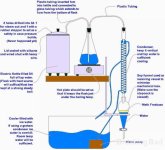You are using an out of date browser. It may not display this or other websites correctly.
You should upgrade or use an alternative browser.
You should upgrade or use an alternative browser.
Steam distillation of methamphetamine
- Thread starter Blade23
- Start date
- Language
- 🇬🇧
- Joined
- Nov 8, 2023
- Messages
- 20
- Reaction score
- 5
- Points
- 3
Code:
The fundamental nature of steam distillation is that it enables a compound or mixture of compounds to be distilled (and subsequently recovered) at a temperature substantially below that of the boiling point(s) of the individual constituent(s). Essential oils contain substances with boiling points up to 200C or higher, including some that are solids at normal temperatures. In the presence of steam or boiling water, however, these substances are volatilized at a temperature close to 100C at atmospheric pressure. The mixture of hot vapours will, if allowed to pass through a cooling system, condense to form a liquid in which the oil and water comprise two distinct layers. Most (but not all) essential oils are lighter than water and form the top layer. The steam that is used for the distillation is generated either within the steel vessel that contains the plant material (by boiling water contained at the base) or by an external boiler.
The use of steam generated within the vessel requires that the leaf be supported above some boiling water by a grid. The water is heated either directly using a fire or by heat exchanger coils. The simplicity of the method makes it suitable for small-scale distillation of essential oils.
If steam is generated, instead, by an external boiler it is introduced into the base of the vessel via an open coil, jets or similar device(s). The advantages of this type of distillation are that it is relatively rapid and capable of greater control by the operator. The vessel can be emptied and recharged quickly and with the immediate reintroduction of steam there is no unnecessary delay in the commencement of the distillation process. Oils produced by this means are more likely to be of acceptable quality than those produced using the more direct method.but what is your question ? For me, it works good without a steam generator.
like this
About Us
Our team brings together the best specialists from different fields.
We are ready to share our experience, discuss difficult issues and find new solutions.

